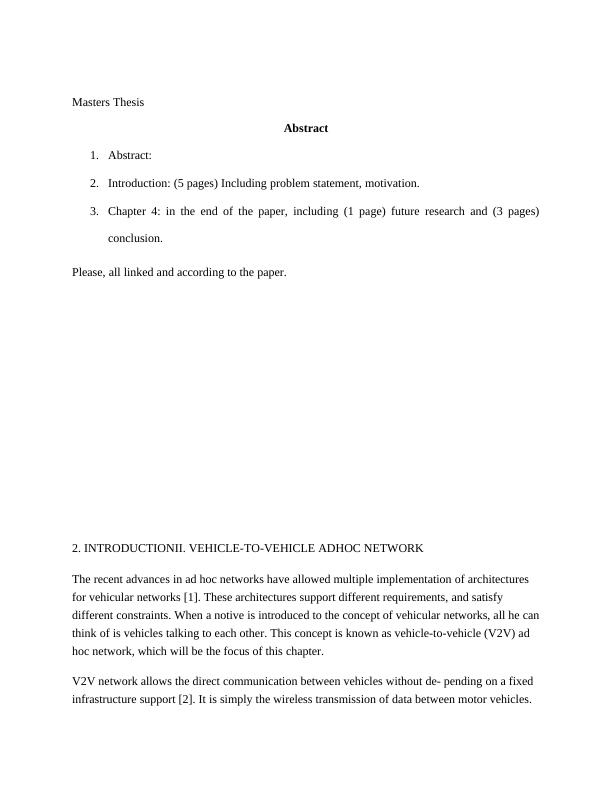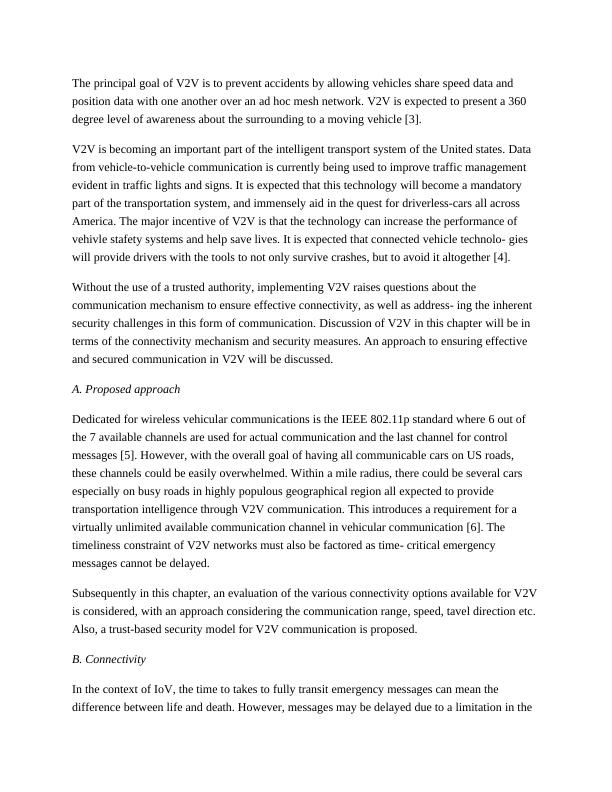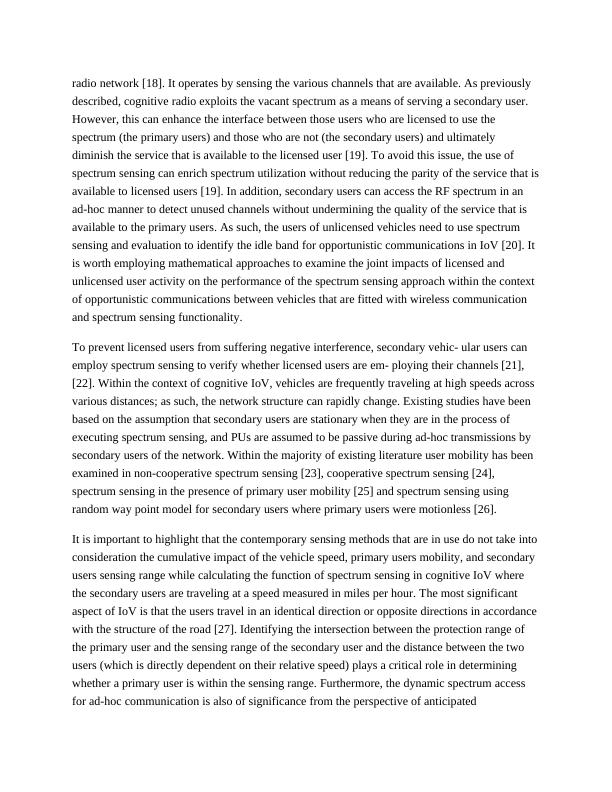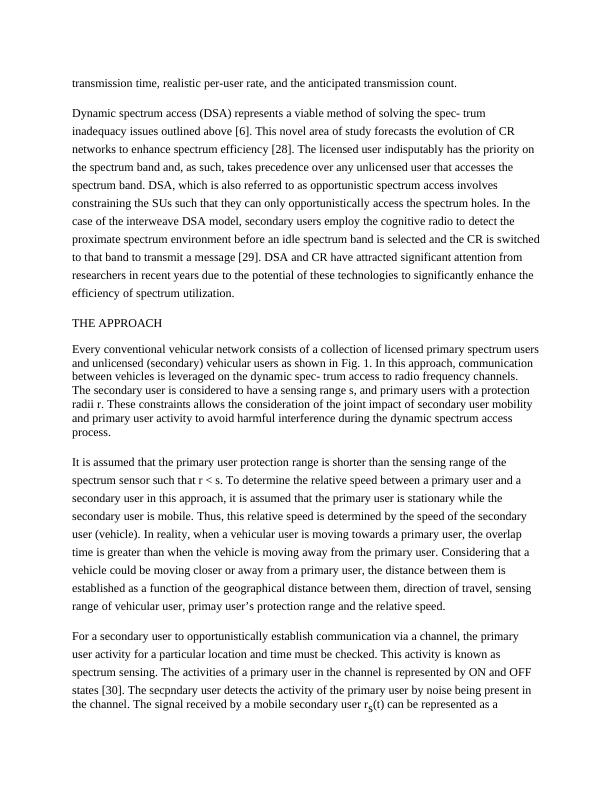Ask a question from expert
Vehicle-to-Vehicle Ad Hoc Network: Connectivity and Security Measures
23 Pages10308 Words225 Views
Added on 2019-09-20
About This Document
This chapter focuses on the concept of vehicle-to-vehicle (V2V) ad hoc network, which allows direct communication between vehicles without depending on a fixed infrastructure support. It discusses the proposed approach for wireless vehicular communication and evaluation of various connectivity options available for V2V. It also explores the trust-based security model for V2V communication and the use of cognitive radio technologies to prevent spectrum scarcity. The chapter concludes with an evaluation of the approach through simulations.
Vehicle-to-Vehicle Ad Hoc Network: Connectivity and Security Measures
Added on 2019-09-20
BookmarkShareRelated Documents
Masters Thesis Abstract1.Abstract: 2.Introduction: (5 pages) Including problem statement, motivation. 3.Chapter 4: in the end of the paper, including (1 page) future research and (3 pages)conclusion. Please, all linked and according to the paper.2. INTRODUCTIONII. VEHICLE-TO-VEHICLE ADHOC NETWORK The recent advances in ad hoc networks have allowed multiple implementation of architectures for vehicular networks [1]. These architectures support different requirements, and satisfy different constraints. When a notive is introduced to the concept of vehicular networks, all he canthink of is vehicles talking to each other. This concept is known as vehicle-to-vehicle (V2V) ad hoc network, which will be the focus of this chapter. V2V network allows the direct communication between vehicles without de- pending on a fixed infrastructure support [2]. It is simply the wireless transmission of data between motor vehicles.

The principal goal of V2V is to prevent accidents by allowing vehicles share speed data and position data with one another over an ad hoc mesh network. V2V is expected to present a 360 degree level of awareness about the surrounding to a moving vehicle [3]. V2V is becoming an important part of the intelligent transport system of the United states. Data from vehicle-to-vehicle communication is currently being used to improve traffic management evident in traffic lights and signs. It is expected that this technology will become a mandatory part of the transportation system, and immensely aid in the quest for driverless-cars all across America. The major incentive of V2V is that the technology can increase the performance of vehivle stafety systems and help save lives. It is expected that connected vehicle technolo- gies will provide drivers with the tools to not only survive crashes, but to avoid it altogether [4]. Without the use of a trusted authority, implementing V2V raises questions about the communication mechanism to ensure effective connectivity, as well as address- ing the inherent security challenges in this form of communication. Discussion of V2V in this chapter will be in terms of the connectivity mechanism and security measures. An approach to ensuring effective and secured communication in V2V will be discussed. A. Proposed approach Dedicated for wireless vehicular communications is the IEEE 802.11p standard where 6 out of the 7 available channels are used for actual communication and the last channel for control messages [5]. However, with the overall goal of having all communicable cars on US roads, these channels could be easily overwhelmed. Within a mile radius, there could be several cars especially on busy roads in highly populous geographical region all expected to provide transportation intelligence through V2V communication. This introduces a requirement for a virtually unlimited available communication channel in vehicular communication [6]. The timeliness constraint of V2V networks must also be factored as time- critical emergency messages cannot be delayed. Subsequently in this chapter, an evaluation of the various connectivity options available for V2Vis considered, with an approach considering the communication range, speed, tavel direction etc. Also, a trust-based security model for V2V communication is proposed. B. Connectivity In the context of IoV, the time to takes to fully transit emergency messages can mean the difference between life and death. However, messages may be delayed due to a limitation in the

channel availability of the IEEE 802.11 channels, which are governed by the IEEE 802.11p standard for wireless vehicular communications. IEEE 802.11 consists of seven channels in total.One of these acts as the common control channel while the remaining six are employed for vehicular communications [6]. As the popularity and prevalence of vehicles that can communicate with one another wirelessly increases, there is a strong possibility that the IEEE 802.11 channel will become overwhelmed, and this could result in delays in messages and scarcity in the radio spectrum [7], [8]. As such, cognitive radio technologies could represent a viable solution by which it is possible to achieve the low latency inter-vehicle communications require while also preventing spectrum scarcity [9]. Cognitive radio is a relatively new technology that involves optimizing the spectrum by exploiting unutilized spectrum holes [10]. The cognitive radio network typically employs three different approaches to identify and exploit unused channels: geo- location database, beacons, and spectrum sensing. Each of these methods will be examined in more depth below: Beacons utilize signals by proliferating signals across different channels with the objective of detecting a free channel [11]. Beacons have been integrated in a range of different applications; for example, [12], [13] , and [14]. One area in which beacons have been particularly useful within the context of IoV is through the use of signals to detect the speed, direction, and position of other vehicles within a network. Beacons are not without their downsides. One major issue with the use of beacons to identify unexploited channels is that their use reduces the efficiency ofthe spectrum because they rely on a high and adequate radio frequency. In addition, the signals sent and received by beacons may suffer interference from alternative sources [15]. The geo-location database is a digital archive that obtains, processes, compiles, and proliferates information about the spectrum band [16]. The CR system accesses the geolocation database scheme, which contains data about the primary user systems, to identify vacant bands. When thisscheme is employed, there is no requirement for the CR users to perform spectrum sensing on the bands; as such, in comparison to the other methods of identifying unused channels, the overheads associated with using the geo-location database are relatively low [17]. Furthermore, as this approach does not involve any sensing errors, it is easier to protect the primary users. To employ this scheme effectively, there is a requirement to establish a stable connection between the spectrum database and the CR users. As such, while it is relatively easy to employ this scheme in a cellular CR system, it is more complex to employ it an ad-hoc situation because a connection of this nature may not exist [8]. For this reason, it is unlikely that the geolocation database scheme will find application in an ad-hoc CR environment. Spectrum sensing is widely considered to represent a fundamental component of a cognitive

radio network [18]. It operates by sensing the various channels that are available. As previously described, cognitive radio exploits the vacant spectrum as a means of serving a secondary user. However, this can enhance the interface between those users who are licensed to use the spectrum (the primary users) and those who are not (the secondary users) and ultimately diminish the service that is available to the licensed user [19]. To avoid this issue, the use of spectrum sensing can enrich spectrum utilization without reducing the parity of the service that isavailable to licensed users [19]. In addition, secondary users can access the RF spectrum in an ad-hoc manner to detect unused channels without undermining the quality of the service that is available to the primary users. As such, the users of unlicensed vehicles need to use spectrum sensing and evaluation to identify the idle band for opportunistic communications in IoV [20]. It is worth employing mathematical approaches to examine the joint impacts of licensed and unlicensed user activity on the performance of the spectrum sensing approach within the context of opportunistic communications between vehicles that are fitted with wireless communication and spectrum sensing functionality. To prevent licensed users from suffering negative interference, secondary vehic- ular users can employ spectrum sensing to verify whether licensed users are em- ploying their channels [21], [22]. Within the context of cognitive IoV, vehicles are frequently traveling at high speeds across various distances; as such, the network structure can rapidly change. Existing studies have been based on the assumption that secondary users are stationary when they are in the process of executing spectrum sensing, and PUs are assumed to be passive during ad-hoc transmissions by secondary users of the network. Within the majority of existing literature user mobility has been examined in non-cooperative spectrum sensing [23], cooperative spectrum sensing [24], spectrum sensing in the presence of primary user mobility [25] and spectrum sensing using random way point model for secondary users where primary users were motionless [26]. It is important to highlight that the contemporary sensing methods that are in use do not take intoconsideration the cumulative impact of the vehicle speed, primary users mobility, and secondary users sensing range while calculating the function of spectrum sensing in cognitive IoV where the secondary users are traveling at a speed measured in miles per hour. The most significant aspect of IoV is that the users travel in an identical direction or opposite directions in accordancewith the structure of the road [27]. Identifying the intersection between the protection range of the primary user and the sensing range of the secondary user and the distance between the two users (which is directly dependent on their relative speed) plays a critical role in determining whether a primary user is within the sensing range. Furthermore, the dynamic spectrum access for ad-hoc communication is also of significance from the perspective of anticipated

transmission time, realistic per-user rate, and the anticipated transmission count. Dynamic spectrum access (DSA) represents a viable method of solving the spec- trum inadequacy issues outlined above [6]. This novel area of study forecasts the evolution of CR networks to enhance spectrum efficiency [28]. The licensed user indisputably has the priority on the spectrum band and, as such, takes precedence over any unlicensed user that accesses the spectrum band. DSA, which is also referred to as opportunistic spectrum access involves constraining the SUs such that they can only opportunistically access the spectrum holes. In the case of the interweave DSA model, secondary users employ the cognitive radio to detect the proximate spectrum environment before an idle spectrum band is selected and the CR is switchedto that band to transmit a message [29]. DSA and CR have attracted significant attention from researchers in recent years due to the potential of these technologies to significantly enhance the efficiency of spectrum utilization. THE APPROACH Every conventional vehicular network consists of a collection of licensed primary spectrum usersand unlicensed (secondary) vehicular users as shown in Fig. 1. In this approach, communication between vehicles is leveraged on the dynamic spec- trum access to radio frequency channels. The secondary user is considered to have a sensing range s, and primary users with a protection radii r. These constraints allows the consideration of the joint impact of secondary user mobility and primary user activity to avoid harmful interference during the dynamic spectrum access process. It is assumed that the primary user protection range is shorter than the sensing range of the spectrum sensor such that r < s. To determine the relative speed between a primary user and a secondary user in this approach, it is assumed that the primary user is stationary while the secondary user is mobile. Thus, this relative speed is determined by the speed of the secondary user (vehicle). In reality, when a vehicular user is moving towards a primary user, the overlap time is greater than when the vehicle is moving away from the primary user. Considering that a vehicle could be moving closer or away from a primary user, the distance between them is established as a function of the geographical distance between them, direction of travel, sensing range of vehicular user, primay user’s protection range and the relative speed. For a secondary user to opportunistically establish communication via a channel, the primary user activity for a particular location and time must be checked. This activity is known as spectrum sensing. The activities of a primary user in the channel is represented by ON and OFF states [30]. The secpndary user detects the activity of the primary user by noise being present in the channel. The signal received by a mobile secondary user rs(t) can be represented as a

function of two hypotheses as in (1). H0 represents the presence of only noise in the channel, andH1 indicating the presence of a primary user. It is important that a misdetection of primary user activity is reduced as it can cause harmful interference. In this vein, it can be said that reducing the misdetection probability is more important than reducing false alarm (false positive) as this does not lead to harmful interference with primary users. An evaluation of the effect of primary user activity and secondary user mobility defined in terms of probability of misdetection of spectrum opportunities and expected overlapping time between static primary user and mobile secondary user is conducted. The following propositions are made based on Definition 1 and Definition 2 to formally analyze event A and event B. Proposition 1: For a separation distance D between a secondary user and primary user, the condition for the primary user being inside the sensing range of secondary user is r < D S. The probability for the event B Pr(B)i.e. the probability that the primary user is inside the sensing range of secondary user and the secondary user detects that the primary user is present in a given channel, is given as: Proposition 2: The probability of misdetection that depends on sensing range of vehicular user, protection range of primary user, velocity of vehicular user and energy detection threshold is expressed as.... Proposition 3: The expected overlap time duration between static primary user and mobile secondary user is... Evaluation To evaluate the approach discussed so far, simulations are conducted with numerical results obtained used to substantiate the formal descriptions given. It is important to note that the secondary user is assumed to be mobile, while the primary user is static in all the simulations. It is further assumed that access points and base stations are primary users, each with its protective range. Secondary users are not expected to use channels actively used by primary users in ithe primary user’s protective range. To understand the effect of the sensing range on the probability of event B, a plot of the variationof Pr(B) vs the sensing range for a given primary user with a protective range r = 110 meter is done. It is oberved that Pr(B) increases with increased sensing range as shown in Fig. 2.

End of preview
Want to access all the pages? Upload your documents or become a member.
Related Documents
Vehicular Communication Systems: Advantages and Challengeslg...
|12
|3427
|405
Vehicular Ad Hoc Network Assignmentlg...
|11
|3514
|300
Analysis of VANETs Architecture and Research Methodologieslg...
|4
|717
|193
Vehicular Ad-Hoc Network: Current Challenges, and Future Perspectivelg...
|23
|4698
|107
Evolving Graphs for Vehicular Ad Hoc Networkslg...
|8
|1459
|444
Mobile Computing and Vehicle Communication: An Annotated Bibliographylg...
|9
|2391
|404